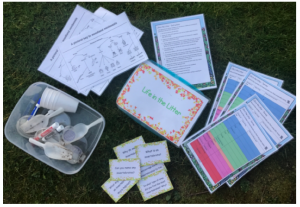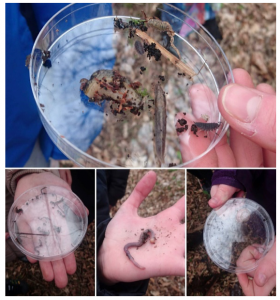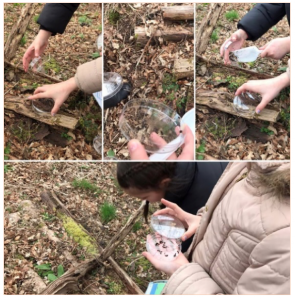Life in the Litter:
‘Life in the Litter’ was a temporarily waymarked geocache located in a woodland, close to the Stirling University entrance. The aim of our geocache was to facilitate the teaching and improve the learners understanding of the scientific concepts of biodiversity and habitat. The area was covered in leaf litter and as a result of recent tree cutting; there was an abundance of log piles. This was therefore, an appropriate place-responsive location as our cache was hidden within a log pile that would be home to a variety of invertebrates and the children could see a real-life example of how invertebrates can be conserved and encouraged to live in a particular location.
The aspect of science that our geocache aimed to explore was biodiversity and habitat. The cache sought to provide an opportunity for the learners to actively engage with this scientific concept through an invertebrate survey. The children used a branched key to identify and classify the invertebrates discovered in the leaf litter and log piles, before recording their findings in a survey. These experiential learning opportunities ensured that there was a high-level of engagement, motivation and challenge within the task. The nature of the geocache activity allowed the children to increase their depth of knowledge in the scientific concepts. This was achieved by allowing the learners to explore the issues of biodiversity and habitat for themselves, which enabled them to reach higher levels of knowledge and understanding. The main link of this learning to the Curriculum for Excellence experiences and outcomes is to SCN 2-01a: I can identify and classify examples of living things, past and present, to help me appreciate their diversity. The activity also ties in with the new benchmarks for science through the use of branched keys, classification and habitat rationale.
The final aspect of this geocache addressed ‘Learning for Sustainability’. The children were asked the question ‘Why do we need invertebrates?’ This began a discussion that purposefully encouraged learners to consider the importance of invertebrates and the benefits they provide us with. The children were then asked ‘How could you encourage more invertebrates to live in your local area’, which combined with the geocache location, facilitated a conversation about ways they could conserve invertebrate species and promote their numbers in their local area, whether that be at home or in their school grounds, e.g. bug hotels, log piles.
The sustainable aspect of this geocache is one that could be further explored in future outdoor lessons or back in the classroom to help the children achieve the experience and outcome SCN 2-02a in Curriculum for Excellence (Scotland): I have contributed to the design or conservation of a wildlife area, as the learners could design and build their own habitats to increase the invertebrate population of their local environment. Additionally, the geocache offered a variety of interdisciplinary opportunities, for example the incorporation of a survey allowed the children’s numeracy skills to be developed and the sustainability discussions that arose allowed for exploration within the social studies curriculum.
TEmporary Geocache (Waymarked only) . by . Nadine Daly and Holly Ramage



